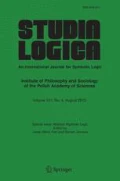Abstract
So-called ‘dynamic’ semantic theories such as Kamp’s discourse representation theory and Heim’s file change semantics account for such phenomena as crosssentential anaphora, donkey anaphora, and the novelty condition on indefinites, but compare unfavorably with Montague semantics in some important respects (clarity and simplicity of mathematical foundations, compositionality, handling of quantification and coordination). Preliminary efforts have been made by Muskens and by de Groote to revise and extend Montague semantics to cover dynamic phenomena. We present a new higher-order theory of discourse semantics which improves on their accounts by incorporating a more articulated notion of context inspired by ideas due to David Lewis and to Craige Roberts.
On our account, a context consists of a common ground of mutually accepted propositions together with a set of discourse referents preordered by relative salience. Employing a richer notion of contexts enables us to extend our coverage beyond pronominal anaphora to a wider range of presuppositional phenomena, such as the factivity of certain sententialcomplement verbs, resolution of anaphora associated with arbitrarily complex definite descriptions, presupposition ‘holes’ such as negation, and the independence condition on the antecedents of conditionals.
Formally, our theory is expressed within a higher-order logic with natural number type, separation-style subtyping, and dependent coproducts parameterized by the natural numbers. The system of semantic types builds on proposals due to Thomason and to Pollard in which the type of propositions (static meanings of sentential utterances) is taken as basic and worlds are constructed from propositions (rather than the other way around as in standard Montague semantics).
Similar content being viewed by others
References
Church Alonzo: A formulation of the simple theory of types. Journal of Symbolic Logic 5, 56–68 (1940)
de Groote, Philippe, Towards abstract categorial grammars, in Association for Computational Linguistics, 39th Annual Meeting and 10th Conference of the European Chapter, Proceedings of the Conference, 2001.
de Groote, Philippe, Towards a Montagovian account of dynamics, in Proceedings of Semantics and Linguistic Theory 16, 2006.
de Groote, Philippe, Typing binding and anaphora: Dynamic contexts as λμ-terms, Presented at the ESSLLI Workshop on Symmetric Calculi and Ludics for Semantic Interpretation, 2008.
Heim, Irene, The Semantics of Definite and Indefinite Noun Phrases, Ph.D. thesis, University of Massachusetts, Amherst, 1982.
Heim, Irene, File change semantics and the familiarity theory of definiteness, in Meaning, Use and the Interpretation of Language, Walter de Gruyter, Berlin, 1983.
Heim, Irene, On the projection problem for presuppositions, in M. Barlow, D. Flickinger, and M. Westcoat, (eds.), WCCFL2: Second Annual West Coast Conference on Formal Linguistics, Stanford University, Stanford, California, 1983.
Henkin Leon: Completeness in the theory of types. Journal of Symbolic Logic 15, 81–91 (1950)
Kamp Hans: A theory of truth and semantic representation. In: Groenendijk, J., Janssen, T., Stokhof, M. (eds.), Formal Methods in the Study of Language, Mathematisch Centrum, Amsterdam (1981)
Kamp Hans, Reyle Uwe: From Discourse to Logic. Kluwer Academic Publishers, Dordrecht (1993)
Kanazawa Makoto: Weak vs. strong readings of donkey sentences and monotonicity inference in a dynamic setting. Linguistics and Philosophy 17(2), 109–158 (1994)
Karttunen Lauri: Presuppositions of compound sentences. Linguistic Inquiry 4(2), 169–193 (1973)
Lambek Joachim, Scott Phil: Introduction to Higher-Order Categorical Logic. Cambridge University Press, Cambridge (1986)
Lewis David: Scorekeeping in a language game. In: Baüerle, R., Egli, U., von Stechow, A. (eds.), Semantics from a Different Point of View, Springer, Berlin (1979)
Martin, Scott, and Carl Pollard, Hyperintensional dynamic semantics: Analyzing definiteness with enriched contexts, in Proceedings of the 15th Conference on Formal Grammar, in press. To appear in Springer Lecture Notes in Computer Science.
Montague, Richard, The proper treatment of quantification in ordinary English, in K. Hintikka, J. Moravcsik, and P. Suppes, (eds.), Approaches to Natural Language, D. Reidel, Dordrecht, 1973.
Muskens, Reinhard, Categorial grammar and discourse representation theory, in Proceedings of COLING, 1994.
Muskens Reinhard: Combining Montague semantics and discourse representation. Linguistics and Philosophy 19, 143–186 (1996)
Muskens Reinhard: Separating syntax and combinatorics in categorial grammar. Research on Language and Computation 5, 267–285 (2007)
Pollard, Carl, Hyperintensional questions, in Proceedings of the 15th Workshop on Logic, Language, Information, and Computation (WoLLIC ’08), no. 5110 in Springer Lecture Notes in Artificial Intelligence, 2008, pp. 261–274.
Pollard Carl: Hyperintensions. Journal of Logic and Computation 18(2), 257–282 (2008)
Potts, Christopher, The Logic of Conventional Implicatures, Oxford University Press, 2005.
Roberts, Craige, Information structure in discourse: Towards an integrated formal theory of pragmatics, in Papers in Semantics, no. 49 inWorking Papers in Linguistics, Ohio State University Department of Linguistics, 1996.
Roberts Craige: Uniqueness in definite noun phrases. Linguistics and Philosophy 26(3), 287–350 (2003)
Roberts, Craige, Pronouns as definites, in M. Reimer, and A. Bezuidenhout, (eds.), Descriptions and Beyond, Oxford University Press, 2004.
Stalnaker Robert: Presuppositions. Journal of Philosophical Logic 2(4), 447–457 (1973)
Stalnaker Robert: Assertion, Pragmatics. Syntax and Semantics 9, 315–332 (1978)
Thomason Richmond: A model theory for propositional attitudes. Linguistics and Philosophy 4, 47–70 (1980)
Author information
Authors and Affiliations
Corresponding author
Rights and permissions
About this article
Cite this article
Martin, S., Pollard, C. A Higher-Order Theory of Presupposition. Stud Logica 100, 727–751 (2012). https://doi.org/10.1007/s11225-012-9427-6
Published:
Issue Date:
DOI: https://doi.org/10.1007/s11225-012-9427-6




